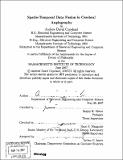Spatio-temporal data fusion in cerebral angiography
Author(s)
Copeland, Andrew David, 1978-
DownloadFull printable version (34.86Mb)
Other Contributors
Massachusetts Institute of Technology. Dept. of Electrical Engineering and Computer Science.
Advisor
Sanjoy K. Mitter.
Terms of use
Metadata
Show full item recordAbstract
This thesis provides a framework for generating the previously unobtained high resolution time sequences of 3D images that show the dynamics of cerebral blood flow. These sequences allow image feedback during medical procedures that can facilitate the detection and observation of stenosis, aneurysms, and clots. The 3D time series is constructed by fusing together a single static 3D image with one or more time sequence of 2D projections. The fusion process utilizes a variational approach that constrains the volumes to have both smoothly varying regions separated by edges and sparse regions of non-zero support. Results are presented on both clinical and simulated phantom data sets. The 3D time series results are visualized using the following tools: time series of intensity slices, synthetic X-rays from an arbitrary view, time series of isosurfaces, and 3D surfaces that show arrival times of contrast using color. This thesis also details the different steps needed to prepare the two classes of data. In addition to the spatio-temporal data fusion algorithm, three new algorithms are presented: a single pass groupwise registration algorithm for registering the time series, a 2D-3D registration algorithm for registering the time series with respect to the 3D volume, and a modified adaptive version of the Cusum algorithm used for determining arrival times of contrast within the 2D time sequences.
Description
Thesis (Ph. D.)--Massachusetts Institute of Technology, Dept. of Electrical Engineering and Computer Science, 2007. Includes bibliographical references (p. 153-167).
Date issued
2007Department
Massachusetts Institute of Technology. Department of Electrical Engineering and Computer SciencePublisher
Massachusetts Institute of Technology
Keywords
Electrical Engineering and Computer Science.